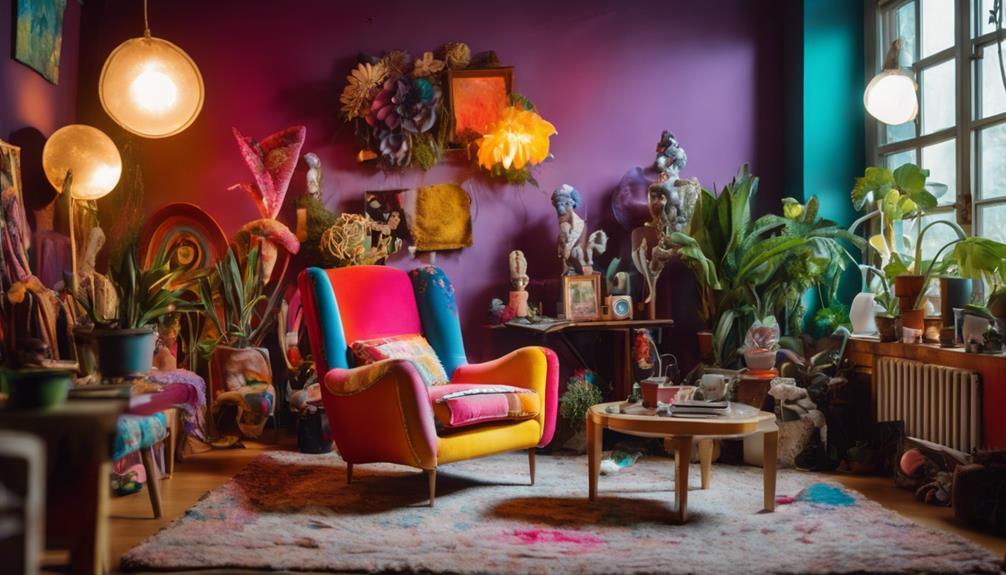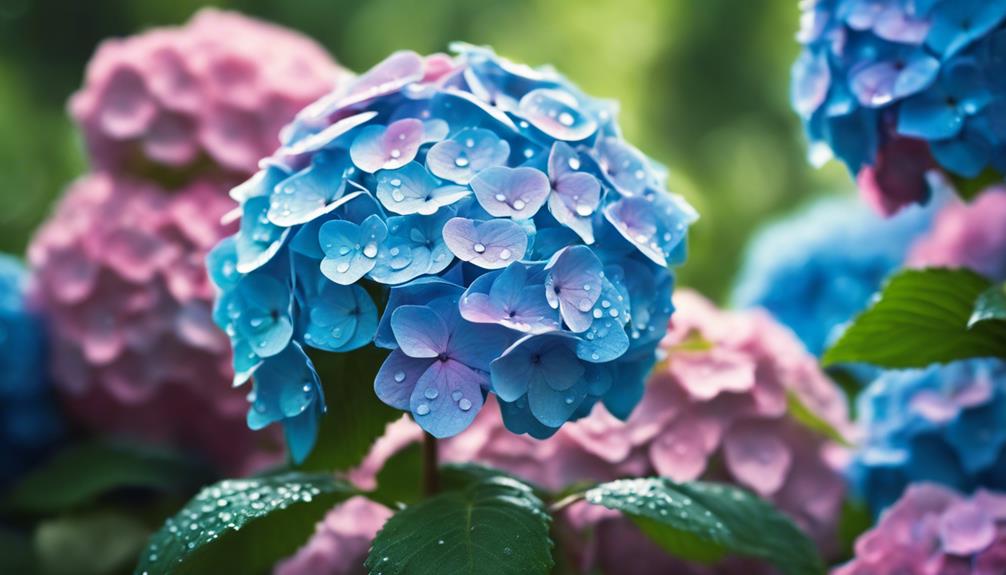To transform your room into a magical haven, start with soft hues like whites and blush pinks for an ethereal color palette. Incorporate delicate textures through light fabrics and floral patterns to create a calming atmosphere. Enhance the space with unique fixtures, like cloud-shaped shelves and glowing orb floor lamps, that add whimsical charm. Don't forget enchanting lighting—fairy lights and luminous pendant fixtures bring warmth and glow. Finally, consider flooring options like plush carpets or galaxy-patterned rugs to ground your decor. Discover how to elevate your space further with creative ideas that will truly amaze!
Key Elements
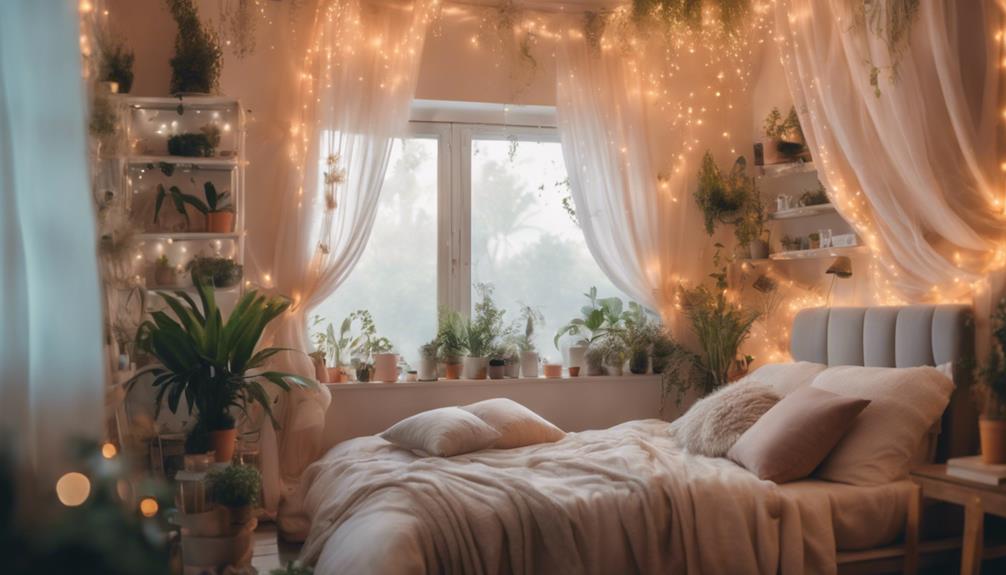
When it comes to creating your ideal room, the right color scheme, materials, and textures are essential.
You'll want to choose soft hues and light fabrics to set a calming tone.
Color Scheme
An ethereal color scheme embraces soft hues like whites, blush pinks, and light blues to create a serene and dreamy environment in your space. These gentle colors serve as the foundation of your home decor, promoting tranquility and elegance.
To enhance this aesthetic, consider incorporating floral patterns in your textiles and decor. They not only connect your room to nature but also amplify the ethereal vibe.
Gold accents, whether in candle holders or mirrors, introduce warmth and sophistication, beautifully complementing the light color palette.
Maximizing natural light is essential for achieving an ethereal atmosphere; use sheer curtains or strategically placed mirrors to brighten the space and showcase your delicate color choices.
Layering textures with light, airy fabrics like linen or chiffon can further enrich the ethereal feel while ensuring a calming ambiance.
Materials
Choosing the right materials is key to achieving that ethereal aesthetic you've envisioned for your space. Start by incorporating light textiles like sheer curtains, linen bedding, and pastel-colored throws. These elements create an airy, soft atmosphere that embodies the ethereal vibe.
Next, consider using natural materials such as wood, stone, and glass in your home decor. These elements enhance your connection to nature and purity, making your space feel more serene. Opt for floral patterns and delicate designs in your cushions and wall decor to evoke beauty and tranquility.
Don't overlook the power of gold accents! Incorporate elegant touches with candle holders, mirrors, and picture frames, as they reflect light and elevate the overall ambiance of your room.
For low-maintenance options, faux plants or dried flowers can still capture the essence of nature while contributing to that ethereal feel.
With these materials, you'll create a magical haven that amazes everyone who enters your home. Embrace these elements, and watch your space transform into a dreamy retreat that reflects your unique style and vision.
Textures
Incorporate a variety of textures to create a layered, inviting atmosphere that enhances the ethereal quality of your space. Spend some time selecting light and airy textiles, like sheer curtains and delicate bed linens in pale hues. These elements set the foundation for an ethereal feel.
Layering soft knits, lace, and smooth silks adds depth while maintaining a lightweight aesthetic vital for your Home Design vision.
Consider incorporating floral patterns in fabrics or wallpaper to evoke a natural connection, creating a serene ambiance fundamental for ethereal decor. Gold accents in textiles, such as embroidered cushions or table runners, can infuse elegance and warmth without overwhelming the lightness of your overall design.
To add tactile softness, include decorative elements like faux fur throws or soft velvets. These not only enhance comfort but also align with the ethereal theme, making your space inviting.
Essential Fixtures and Furniture
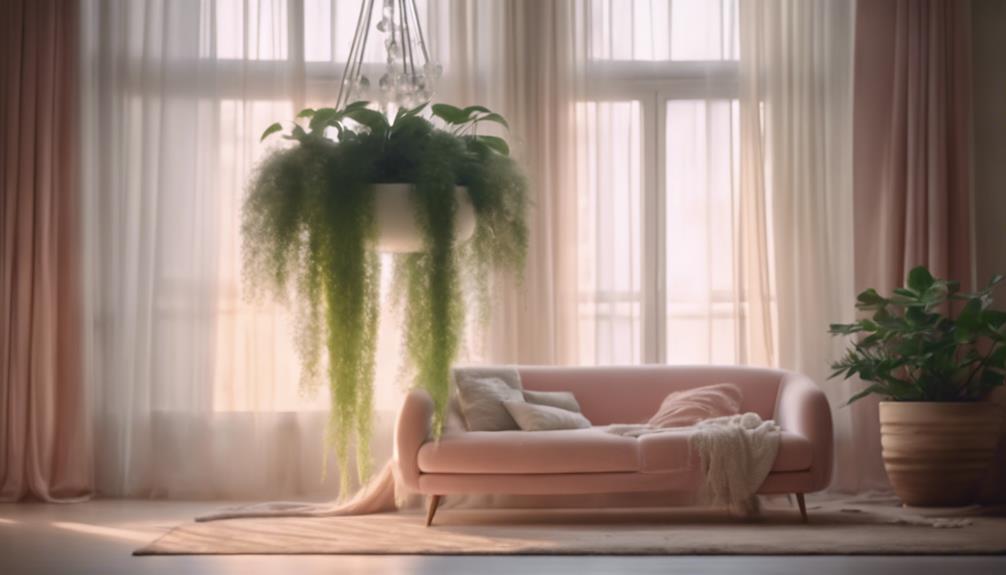
When you think about essential fixtures and furniture, consider unique pieces that enhance your room's ethereal vibe.
Floating cloud-shaped shelves can add whimsy, while a hanging starry night canopy creates a dreamy atmosphere.
Don't forget glowing moon phase wall art to tie the whole look together with a touch of magic.
Floating Cloud-Shaped Shelves
Floating cloud-shaped shelves bring a whimsical touch to your room decor, combining functionality with a dreamy aesthetic that enhances any space. These shelves evoke the lightness of clouds drifting in the sky, making them a charming addition to your ethereal decor.
Crafted from lightweight materials like MDF or plywood, these shelves often feature soft, rounded edges that reinforce their cloud-like appearance. You can find them in various pastel colors or classic white, allowing them to seamlessly blend with your existing color palette. Their playful design makes them perfect for displaying delicate decor items, such as fairy lights, small plants, or framed art, contributing to an airy and uncluttered atmosphere.
Installation is typically straightforward, enabling you to customize your wall spaces easily. You can create playful, layered displays that reflect your personal style while maximizing your room's functionality.
Whether you use them in a nursery, a cozy reading nook, or a whimsical bedroom, floating cloud-shaped shelves transform your space into a magical haven. Embrace this enchanting decor element and let your creativity soar as you enhance your room's enchanting atmosphere.
Hanging Starry Night Canopy
Transform your room into a celestial escape with a hanging starry night canopy that creates a cozy and enchanting atmosphere. You can craft this dreamy look using sheer, lightweight fabrics in pale colors like white or soft blue. These colors help to establish an ethereal vibe, making your space feel more inviting.
To enhance the magic, incorporate twinkling fairy lights within the canopy. This addition mimics a starlit sky and adds warmth, turning your room into a serene retreat. Use curtain rods or tension wires to suspend the canopy from the ceiling, ensuring it drapes gracefully and becomes a stunning focal point.
Consider adding decorative elements like celestial-themed wall art or hanging stars to complement the canopy. These accents can elevate the overall ambiance and emphasize the enchanting theme.
For the ultimate immersive experience, position your bed or seating area directly underneath the canopy. This setup encourages relaxation and wonder, making it the perfect spot to unwind after a long day.
With a hanging starry night canopy, you'll transform your room into a magical haven that's sure to surprise and delight anyone who enters.
Glowing Moon Phase Wall Art
Incorporating glowing moon phase wall art into your decor adds a mesmerizing focal point that enhances the celestial theme established by your starry night canopy. These stunning pieces not only evoke a sense of magic but also connect you to nature, creating a serene atmosphere in your room.
The soft, ambient lighting they provide casts a calming glow at night, making your space feel tranquil and inviting.
You'll find glowing moon phase art available in various styles, crafted from materials like wood, canvas, or acrylic. This variety allows you to customize the artwork to fit your personal decor preferences perfectly.
Many designs feature intricate details and textures that bring depth and visual interest, harmonizing beautifully with light textiles and floral patterns often seen in ethereal decor.
Lighting Ideas
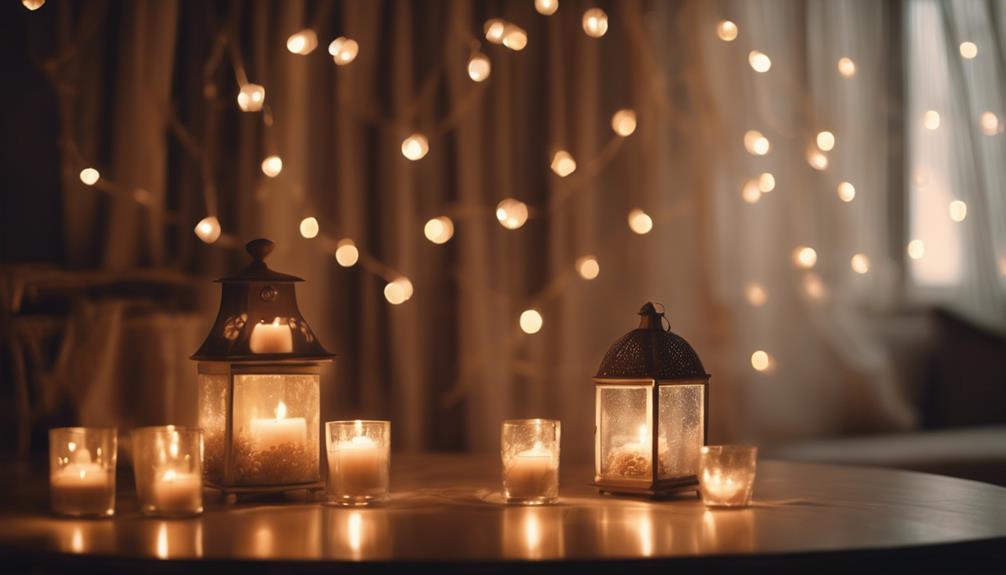
When it comes to lighting ideas, you can transform your space with a few creative touches.
Consider installing fairy light curtains for a whimsical look or adding luminous crystal pendant fixtures for a touch of elegance.
Don't forget about glowing orb floor lamps and bioluminescent wall sconces to enhance both functionality and ambiance in your room.
Fairy Light Curtain Installation
Fairy light curtains add a magical touch to your space, creating a soft glow that enhances the overall atmosphere.
To install them, consider using a tension rod or curtain wire to hang the lights, ensuring they drape beautifully across your window or wall. This method not only makes installation simple but also allows for easy adjustments.
When selecting your fairy lights, opt for warm white or pastel colors to truly capture that ethereal aesthetic. These hues work well with the pale color palettes often associated with whimsical decor.
For added versatility, choose fairy lights that come with adjustable brightness settings or remote controls. This way, you can customize the ambiance to suit various occasions, from cozy nights in to lively gatherings.
To amplify the dreamy effect, think about incorporating sheer or light fabric curtains alongside your fairy lights. This combination will diffuse the light, creating a visually stunning display that captivates anyone who enters your room.
With these installations, you'll transform your space into a magical haven, perfect for relaxation or entertaining guests.
Luminous Crystal Pendant Fixtures
Luminous crystal pendant fixtures elevate your ethereal room decor by creating a stunning interplay of light and shadow that fascinates anyone who enters. These elegant fixtures not only enhance your space but also add a touch of sophistication. With a variety of crystal styles, including cut glass and faceted designs, they refract light into a spectrum of colors, enriching the magical ambiance.
When choosing a crystal pendant, consider the size and scale to guarantee it becomes a fascinating focal point without overwhelming your decor. A well-proportioned fixture draws the eye and complements your overall design. You'll find options in various finishes like gold or silver, which can seamlessly blend with your ethereal theme while adding warmth and shine.
Installing dimmable crystal pendants is another great idea. This allows you to adjust the lighting to create a serene atmosphere, perfect for relaxation or romantic settings. Whether you prefer a dramatic glow or a soft shimmer, these fixtures can transform the mood of your space.
Glowing Orb Floor Lamps
Transform your space with glowing orb floor lamps that cast a soft, diffused light, enhancing the ethereal ambiance of your room. These lamps create a serene and magical atmosphere that's perfect for relaxation and reflection.
Available in various sizes and colors, you can strategically place them to highlight reading nooks or corners adorned with plants, adding to your room's natural aesthetic.
With adjustable brightness settings, you can easily customize the light intensity to suit different moods and activities. Whether you're enjoying a cozy evening or hosting a vibrant gathering, these lamps adapt to your needs.
Some designs even incorporate smart technology, allowing you to control the lighting through apps or voice commands, seamlessly blending modern convenience with an ethereal feel.
Constructed from materials like frosted glass or soft plastic, glowing orb lamps guarantee a gentle glow that complements the pale color palettes typical of ethereal decor. This enhances the overall lightness of your space, making it feel airy and inviting.
Bioluminescent Wall Sconces
Bioluminescent wall sconces bring a magical glow to your space, mimicking the enchanting light found in nature. Using LED technology, these sconces create a soft, ethereal lighting effect that enhances the ambiance of any room. Their designs often draw inspiration from marine life, featuring shapes like jellyfish or glowing coral. This whimsical touch aligns perfectly with an ethereal aesthetic, making them a standout addition to your decor.
Not only are these sconces visually striking, but they're also energy-efficient, boasting a lifespan of up to 25,000 hours. This makes them a sustainable choice for long-lasting illumination. Available in various colors, you can customize your lighting to set the mood, from serene blues to warm, inviting yellows.
Installation is typically straightforward, with options for hardwired or plug-in models. This versatility allows you to highlight specific areas of your room, whether you want to create a cozy reading nook or a dreamy ambiance for entertaining.
With bioluminescent wall sconces, you can effortlessly transform your space into a magical haven that will amaze everyone who enters.
Decorative Elements
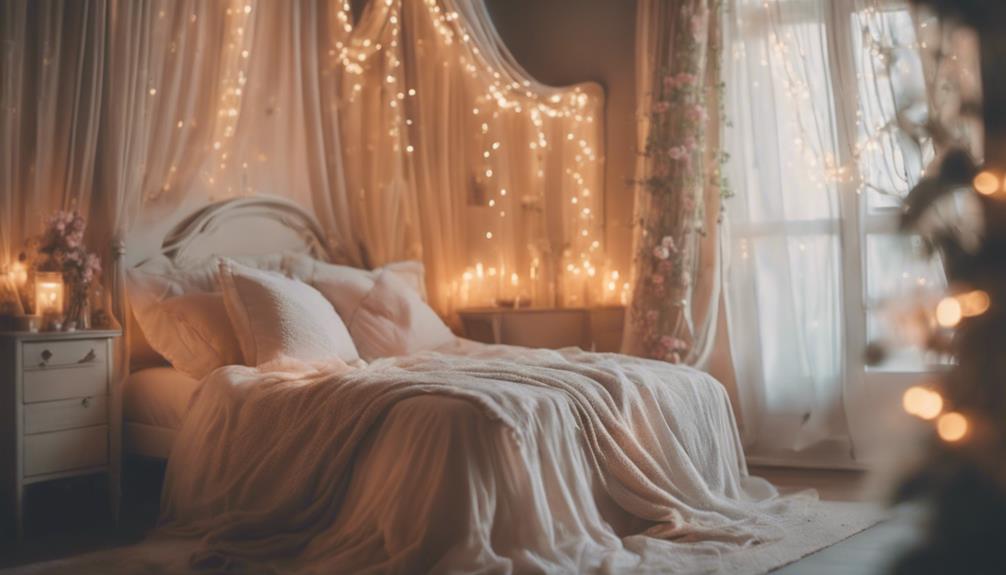
When it comes to decorative elements, think about how celestial-themed throw pillows can add a dreamy touch to your space.
A moonlit dreamcatcher wall hanging can create a sense of whimsy, while a starry sky wall mural transforms your room into a tranquil retreat.
These accents not only enhance the aesthetic but also invite a calming atmosphere.
Celestial-Themed Throw Pillows
Celestial-themed throw pillows bring a touch of whimsy and elegance to your space, featuring designs inspired by stars, moons, and galaxies. These pillows often utilize deep navy, soft gold, and silver hues, enhancing the ethereal aesthetic you crave. They can serve as focal points in your room, effortlessly adding charm while promoting a serene vibe.
To maintain that soft and airy feel, look for pillows made from light fabrics like linen or cotton. Heavier materials can detract from the enchanting atmosphere you're aiming for. When you incorporate celestial motifs, you create a cohesive design that pairs beautifully with other celestial decor, such as wall art or bed linens.
These pillows are also incredibly versatile, allowing you to mix and match with various patterns. This flexibility makes them perfect for layering textures, which adds depth to your ethereal room design. Whether you choose to scatter them across your bed or arrange them on your sofa, celestial-themed throw pillows will instantly elevate your space and create a magical haven that will amaze everyone who enters.
Moonlit Dreamcatcher Wall Hanging
A moonlit dreamcatcher wall hanging adds a touch of magic to your space, seamlessly blending natural elements with celestial motifs. This striking piece can serve as a focal point in your ethereal room, creating a sense of wonder and tranquility. You'll love how the soft, pale colors, like white and silver, align perfectly with the ethereal aesthetic, enhancing your room's light and airy atmosphere.
Incorporating materials such as feathers, beads, and twine introduces texture and depth, reflecting the beauty of nature while maintaining a delicate, whimsical vibe. Each element contributes to a soothing ambiance that invites relaxation and inspiration. Plus, the dreamcatcher symbolizes protection and positivity, making it not just a beautiful decorative piece but also a meaningful addition to your space.
To maximize its enchanting effect, hang your dreamcatcher near a window. This way, natural light filters through, casting mesmerizing shadows and enhancing the room's magical ambiance.
With a moonlit dreamcatcher wall hanging, you create a sanctuary that captivates the imagination and soothes the soul, transforming your room into a truly magical haven.
Starry Sky Wall Mural
Transform your room into a dreamy sanctuary by adding a starry sky wall mural that captures the enchanting beauty of the night sky. This stunning mural can create a mesmerizing focal point, enhancing the ethereal aesthetic of your space. Opt for designs featuring gradients of deep blues and purples, adorned with shimmering white or gold stars to evoke a celestial atmosphere.
To take it a step further, consider incorporating glow-in-the-dark elements within the mural. This adds an enchanting effect, allowing the stars to softly illuminate your room at night, transforming it into a magical haven. For easy installation, choose removable or peel-and-stick options. This way, you can change your decor whenever you want without damaging your walls.
To complete the look, pair your mural with soft ambient lighting like fairy lights or lanterns. This combination creates a cohesive and magical environment that enhances the overall ethereal vibe. With just a starry sky wall mural and thoughtful lighting, you'll create a space that everyone will admire, turning your room into a true sanctuary of enchantment.
Flooring
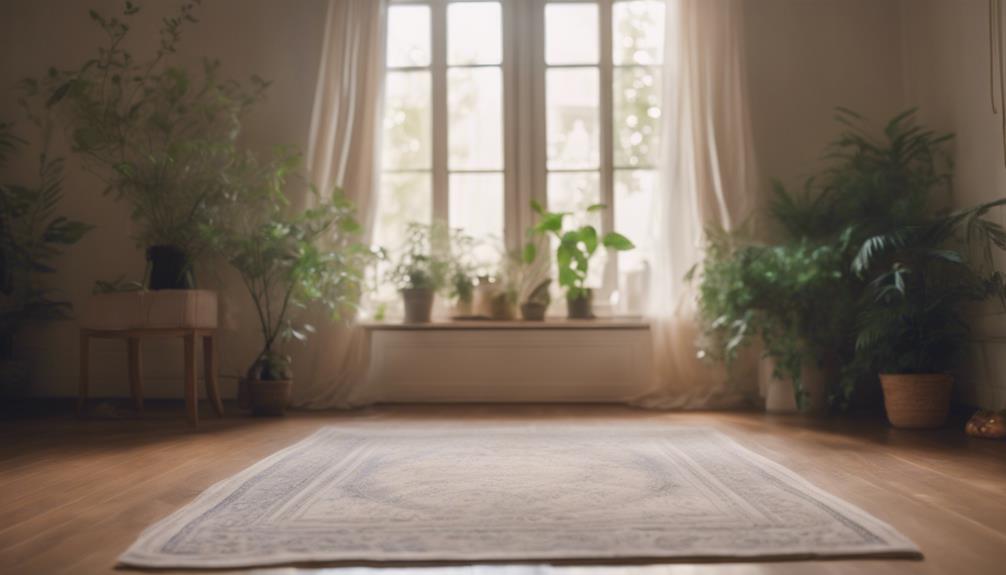
When choosing flooring, think about how soft, plush carpet in teal can add a cozy touch to your room.
You might also consider glittering stardust vinyl, which creates a whimsical feel underfoot.
Don't forget a galaxy-patterned area rug to tie everything together and enhance your ethereal theme!
Soft, Plush Carpet in Teal
Soft, plush teal carpets create a soothing foundation that enhances the ethereal beauty of your room decor. This luxurious touch not only elevates the aesthetic but also invites comfort into your space. The tranquil hue of teal harmonizes beautifully with pale colors like whites, pinks, and blues, ensuring a cohesive and serene look.
Opting for a high-pile carpet adds depth and texture, emphasizing the lightness and softness typical of ethereal themes. You'll love how the plush fibers absorb sound, cultivating a peaceful environment perfect for relaxation and reflection. Imagine sinking your feet into this soft oasis after a long day.
To maintain that ethereal vibe, consider choosing carpets made from natural or eco-friendly materials. This connection to nature reinforces the magical haven you're creating while promoting sustainability. Teal carpets serve not just as flooring but as an essential component of your room's atmosphere, allowing you to transform any space into a tranquil retreat.
With the right teal carpet, you'll experience a delightful blend of comfort and style, making your room the envy of everyone who steps inside. Embrace the ethereal with a soft, plush foundation that truly captivates!
Glittering Stardust Vinyl Flooring
Adding Glittering Stardust Vinyl Flooring instantly brings the enchanting allure of a starry night into your space, creating a mesmerizing foundation for your decor. This shimmering surface mimics the celestial beauty of the night sky, giving your room an ethereal touch that captivates anyone who steps inside.
Not only does this flooring elevate your aesthetic, but it's also incredibly durable and resilient. It's perfect for high-traffic areas, ensuring that you can enjoy its luxurious feel without worrying about wear and tear. Plus, its water-resistant and easy-to-clean properties mean maintaining your magical haven is a breeze.
You'll find Glittering Stardust Vinyl available in various colors and patterns, allowing you to seamlessly complement your existing decor style. Whether you prefer a subtle shimmer or a more vibrant display, there's an option for you.
Installation is straightforward, too, with peel-and-stick or traditional glue-down methods that allow for quick transformation.
With Glittering Stardust Vinyl Flooring, you can create a dreamy retreat that enchants both you and your guests, all while enjoying the practicality and comfort that this flooring offers.
Galaxy-Patterned Area Rug
Galaxy-patterned area rugs transform your space into a cosmic wonderland, featuring vibrant designs that capture the beauty of the night sky. With deep blues, purples, and star motifs, these rugs serve as stunning focal points in any ethereal-themed room. You'll love how they promote a sense of wonder and tranquility, perfectly complementing the lightness and beauty of nature-inspired decor.
These rugs come in various materials like plush polyester and durable nylon, ensuring comfort underfoot while providing longevity and ease of maintenance. You won't have to worry about wear and tear, making them a practical choice for daily use.
In addition to their aesthetics, galaxy-patterned rugs help define spaces within your room. Imagine creating a cozy nook for reading or relaxation, all while adding a dash of whimsy and imagination to your decor. Available in a range of sizes, these rugs can fit both small and large rooms, giving you the versatility to enhance your overall ethereal atmosphere.
Conclusion
By incorporating these ethereal decor ideas, you can easily transform your room into a magical haven that captivates everyone who enters.
Focus on key elements, choose essential fixtures and furniture that resonate with your vision, and play with lighting to create an enchanting atmosphere.
Don't forget the little decorative touches that add personality and warmth.
With the right flooring, your space will feel cohesive and inviting.
Embrace your creativity, and watch your dream room come to life!


